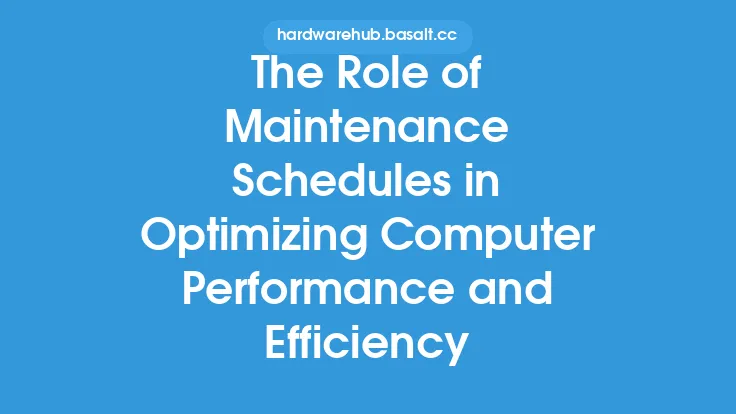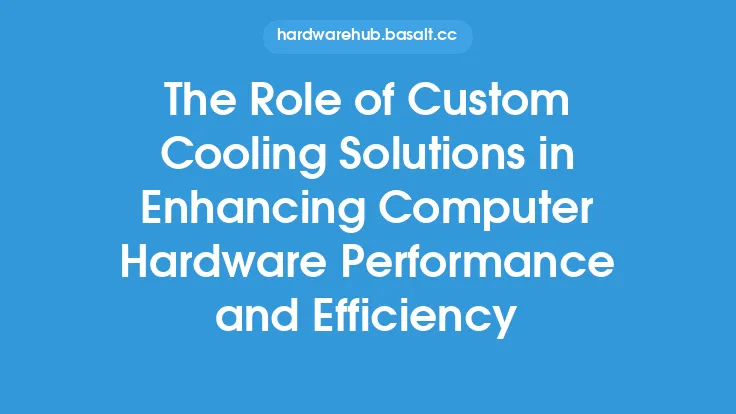To improve computer performance and efficiency, calibration techniques play a crucial role. Calibration, in the context of computer hardware, refers to the process of configuring and adjusting the settings of various components to ensure they operate at optimal levels. This process involves fine-tuning the hardware to match the specific requirements of the system, thereby enhancing overall performance, reducing errors, and increasing the lifespan of the components. In this article, we will delve into the various calibration techniques that can be applied to different components of a computer system to achieve improved performance and efficiency.
Introduction to Calibration Techniques
Calibration techniques are designed to optimize the performance of computer hardware by adjusting the settings of various components to match the specific requirements of the system. These techniques can be applied to a wide range of components, including processors, memory, storage devices, graphics cards, and peripherals. The goal of calibration is to ensure that each component operates at its optimal level, thereby enhancing overall system performance, reducing errors, and increasing the lifespan of the components. Calibration techniques can be broadly categorized into two types: hardware calibration and software calibration. Hardware calibration involves adjusting the physical settings of the components, such as voltage, frequency, and timing, while software calibration involves adjusting the settings of the operating system, drivers, and applications.
Processor Calibration
Processor calibration is a critical aspect of computer performance optimization. The processor, also known as the central processing unit (CPU), is the brain of the computer system, responsible for executing instructions and performing calculations. To calibrate the processor, several techniques can be employed, including overclocking, underclocking, and voltage adjustment. Overclocking involves increasing the clock speed of the processor to enhance performance, while underclocking involves reducing the clock speed to reduce power consumption and heat generation. Voltage adjustment involves adjusting the voltage supplied to the processor to optimize performance and reduce power consumption. These techniques require careful consideration of the processor's specifications, cooling system, and power supply to avoid damage or instability.
Memory Calibration
Memory calibration is another important aspect of computer performance optimization. The memory, also known as random access memory (RAM), plays a critical role in storing data and instructions for the processor. To calibrate the memory, several techniques can be employed, including timing adjustment, voltage adjustment, and memory overclocking. Timing adjustment involves adjusting the timing settings of the memory, such as the CAS latency, RAS-to-CAS delay, and write recovery time, to optimize performance. Voltage adjustment involves adjusting the voltage supplied to the memory to optimize performance and reduce power consumption. Memory overclocking involves increasing the clock speed of the memory to enhance performance. These techniques require careful consideration of the memory's specifications, processor, and chipset to avoid instability or data corruption.
Storage Device Calibration
Storage device calibration is essential for optimizing the performance of hard disk drives (HDDs) and solid-state drives (SSDs). To calibrate a storage device, several techniques can be employed, including disk formatting, partitioning, and optimization. Disk formatting involves preparing the storage device for use by creating a file system and allocating space for data storage. Partitioning involves dividing the storage device into separate sections, each with its own file system and allocation of space. Optimization involves adjusting the settings of the storage device, such as the block size, cache size, and queue depth, to optimize performance. These techniques require careful consideration of the storage device's specifications, operating system, and applications to avoid data loss or corruption.
Graphics Card Calibration
Graphics card calibration is critical for optimizing the performance of graphics-intensive applications, such as games and video editing software. To calibrate a graphics card, several techniques can be employed, including clock speed adjustment, voltage adjustment, and memory overclocking. Clock speed adjustment involves adjusting the clock speed of the graphics processing unit (GPU) to enhance performance. Voltage adjustment involves adjusting the voltage supplied to the GPU to optimize performance and reduce power consumption. Memory overclocking involves increasing the clock speed of the graphics memory to enhance performance. These techniques require careful consideration of the graphics card's specifications, cooling system, and power supply to avoid damage or instability.
Peripheral Calibration
Peripheral calibration is essential for optimizing the performance of peripherals, such as keyboards, mice, and printers. To calibrate a peripheral, several techniques can be employed, including device driver updates, settings adjustments, and firmware updates. Device driver updates involve updating the software that controls the peripheral to ensure compatibility and optimal performance. Settings adjustments involve adjusting the settings of the peripheral, such as the sensitivity, acceleration, and polling rate, to optimize performance. Firmware updates involve updating the firmware of the peripheral to ensure compatibility and optimal performance. These techniques require careful consideration of the peripheral's specifications, operating system, and applications to avoid errors or instability.
Conclusion
In conclusion, calibration techniques play a crucial role in improving computer performance and efficiency. By applying these techniques to various components of a computer system, users can optimize performance, reduce errors, and increase the lifespan of the components. Whether it's processor calibration, memory calibration, storage device calibration, graphics card calibration, or peripheral calibration, each technique requires careful consideration of the component's specifications, operating system, and applications to avoid damage, instability, or data corruption. By following these techniques and best practices, users can ensure that their computer system operates at optimal levels, providing a seamless and efficient computing experience.





